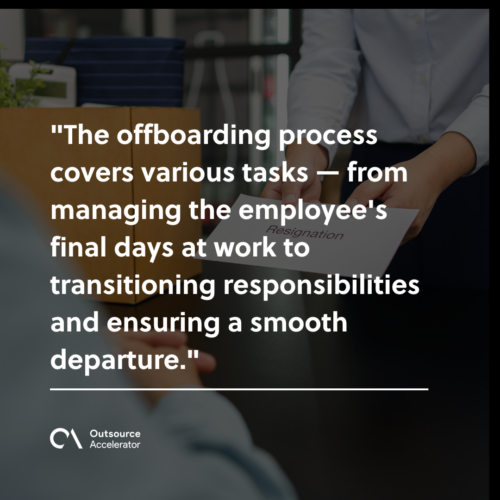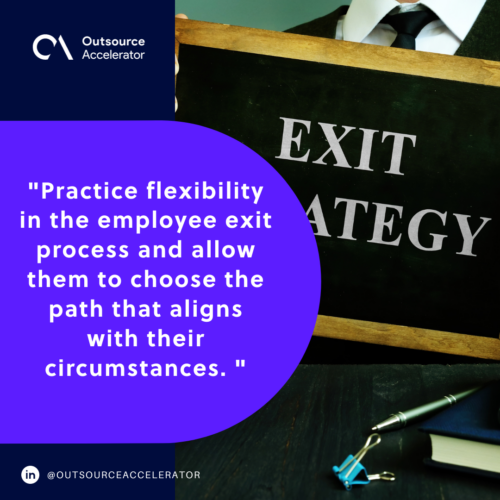Breaking down the employee exit process

When an employee leaves a company, it’s more than just a simple farewell.
The exit process is a crucial stage in the employee lifecycle that requires careful planning and execution.
Despite its importance, Zippia revealed that 71% of organizations don’t have a formal offboarding process.
To help you get started, let’s break down the employee exit process and why it’s needed. We’ll also provide practical tips to make it smoother for both employees and employers.
What is the employee exit process?
The employee exit process (aka offboarding process) refers to the series of steps taken when an employee leaves a company. It occurs whether the worker resigns, retires, or gets terminated.
The offboarding process covers various tasks — from managing the employee’s final days at work to transitioning responsibilities and ensuring a smooth departure.
The exit process is essential as it provides closure for the departing employee. It also allows the company to tie up loose ends and ensure a seamless transition for the rest of the team.
It’s a structured and systematic approach aimed at facilitating a smooth exit for the employee while minimizing disruptions to the organization.

Why you need an employee exit process
Having a well-defined employee exit process is crucial for several reasons.
Maintain good employee relationships
Firstly, it allows the company to maintain a positive relationship with departing employees.
By treating employees with respect and offering a well-structured offboarding, companies can leave a lasting positive impression even after the worker has moved on.
This can be beneficial in terms of potential future collaborations or referrals.
Smooth workload transition
Secondly, offboarding helps transfer knowledge and workload to other team members.
Without a proper exit process, there is a risk of losing crucial information and experiencing a disruption in workflow. This can result in lost productivity and increased stress for other workers.
Compliance with the law
Lastly, having an established offboarding process helps the company maintain compliance with legal and regulatory requirements. It also aids in safeguarding precious company information.
In fact, Folks HR reported that 20% of companies were victims of security breaches linked to former employees.
A thorough employee exit process ensures all necessary paperwork is completed and various security risks are minimized. Failure to comply with these obligations could lead to legal consequences and damage to the company’s reputation.
6 steps of the employee exit process
The employee exit process typically involves several key steps to ensure a comprehensive and organized transition.
Here are the six essential stages:
1. Notice period and resignation
When an employee decides to or is urged to leave, the first step is the submission of their resignation or termination. This triggers the commencement of the notice period.
This stage allows the company to make necessary arrangements for workload distribution and initiate the exit process.
2. Exit interview
Conducting an exit interview is valuable in understanding the reasons behind the employee’s departure.
Harvard Business Review noted that to make an exit interview count, it should act as a mechanism for companies to learn about and from their most important resource — their human capital.
The EI provides an opportunity for open communication and allows the collection of feedback on various aspects, including:
- Work environment
- Leadership and management
- Overall satisfaction
3. Documentation and paperwork
HR should ensure that all necessary paperwork is completed, including exit forms and non-disclosure agreements.
It is also crucial to ensure that all company property, such as laptops, access cards, and any other equipment, is returned. This step helps prevent data breaches and other security risks.
4. Responsibilities and knowledge transfer
To prevent a loss of institutional knowledge, there should be a systematic process for transferring information from the departing employee.
This should be done whether to their successor or relevant team members. It can involve documentation, training sessions, or shadowing opportunities.

5. Final settlement
Completing the financial aspects of the exit process is vital. This involves the settlement of dues, benefits, and any outstanding payments.
This ensures that the employee leaves with a clear understanding of their financial standing with the company.
6. Exit announcement:
Informing the team about the departure is also essential in maintaining transparency. Clear communication helps manage expectations and prepares the team for the transition.
Key elements of an employee exit checklist
An employee exit checklist serves as a guide to ensure no crucial steps are overlooked during offboarding.
Here are key elements to include in an effective offboarding checklist:
- Exit interview questions. Prepare a set of well-thought-out questions for the exit interview. This should cover the employee’s experience, reasons for leaving, and suggestions for improvement.
- Property return procedure. Clearly outline the steps and procedures for returning company property. This includes instructions for returning electronic devices, access cards, and other items issued.
- Terminate access and accounts. Disable the departing employee’s clearance to company systems and networks to protect sensitive information and prevent unauthorized access.
- Knowledge transfer plan. Identify the employee’s critical tasks and responsibilities. Create a plan to transfer them to other team members or new hires.
- Final settlement checklist. Create a checklist for the financial settlement process. Include details about dues, benefits, and any other financial obligations.
- Communication plan. Outline a communication plan for informing the team about the departure. Have a timeline for announcements, details to be shared, and any extra support needed for the team during the transition.
- Offboarding notifications. Notify the relevant departments, such as IT and security, about the employee’s departure. This is to minimize any potential security risks.
Tips to prepare for an employee exit
Preparing for an employee exit involves more than just following a checklist. Here are some practical tips to enhance the preparation process:
Have a defined employee exit process
Establish a clear and well-documented employee exit process shared with all employees. This ensures consistency and transparency throughout the organization.
Proactive communication
Encourage open communication with employees throughout their tenure. This can help identify potential issues early on and provide a chance to address concerns before they escalate to a departure.
Continuous feedback
Implement regular feedback mechanisms, such as performance reviews and surveys, to understand employee satisfaction and concerns.
This ongoing feedback loop can contribute to a more positive work environment and reduce the likelihood of sudden resignations.
Succession planning
Invest in succession planning to identify and groom potential candidates for key roles within the company.
This proactive approach ensures a smoother transition when an employee decides to leave, minimizing disruptions to the workflow.
Employee exit process best practices
Employee exits are inevitable, and there will come a time when you actually have to deal with them. To ensure a seamless and positive offboarding process, consider these best practices:
Start early
Begin the exit process as soon as an employee gives notice. This allows ample time for a smooth transition and minimizes the risk of losing knowledge or disrupting workflow.
Treat employees with respect and empathy
Acknowledge the departing employee’s contributions and ensure they feel valued throughout the procedure. A positive experience during offboarding can leave a lasting impression.
Maintain confidentiality
Respect the departing employee’s privacy and ensure confidentiality when handling their personal information and sensitive feedback.
Offer employee assistance programs (EAP)
Offer employee assistance programs (EAP) to provide support for departing employees, especially in cases where personal challenges drive the decision to leave.
This can include counseling services or resources to facilitate a smooth transition out of their roles and responsibilities.
Provide positive transition support
Create a program to help exiting employees with things like resume building, interview prep, and networking. This shows that the company cares about their success even after they leave.
Providing this support leaves a positive impression, builds goodwill, and enhances the company’s reputation as a caring employer.
Have flexible exit paths
Recognize that each employee’s exit journey is unique, and a one-size-fits-all approach may not be suitable.
Practice flexibility in the employee exit process and allow them to choose the path that aligns with their circumstances. This could include options like phased exits, part-time transitions, or sabbaticals.
Organizations demonstrate empathy and understanding by accommodating individual needs. It strengthens the bond with departing employees and leaves the door open for potential future collaboration.

Make the employee exit process smoother
As we navigate the intricate terrain of employee exits, it becomes evident that a smoother transition is not just a transactional affair. It’s also a collaborative effort between departing individuals and the organizations they leave behind.
Transparent communication emerges as a cornerstone, allowing both parties to share their perspectives openly. This fosters an environment where professionalism and respect merge, setting the stage for a positive exit experience.
Mentorship programs and alumni networks can add a layer of human connection to the departure process.
Imagine employees having mentors to guide them through the transition, providing insights and support as they step into new horizons.
Moreover, the establishment of alumni networks ensures that the organizational bond doesn’t sever completely.
Instead, it transforms into a web of connections, fostering collaboration and potential future partnerships. Companies are now willing to welcome back so-called “boomerang employees.”
Organizations can transform what could be a challenging phase into a smooth and positive experience for both employees and the company at large by:
- Embracing proactive measures
- Maintaining a culture of open communication
- Implementing thoughtful initiatives.
Overall, the employee exit process is not a mere formality — but an opportunity for growth, learning, and relationship-building.







 Independent
Independent




